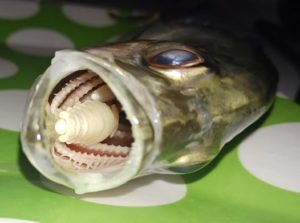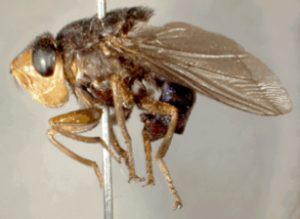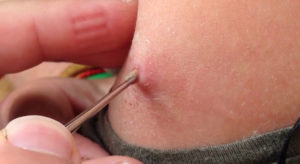After reflecting upon my run in with the Cordyceps fungus and pondering the world of mind-controlling parasites, I end such ruminations with a look at some parasites which, quite simply, give me the creeps. My mind rushes back over forty years to my undergraduate parasitology course. The class was taught by William Hopp. Doctor Hopp was a professor of the old school. He was well-versed in the whole gamut of subjects that fall under the umbrella of natural history. It seems that this discipline has fallen from favor lately as the biological sciences have rapidly progressed into more specialized realms such as cell biology, molecular biology, genomics, forensics, and physiological ecology. Once upon a time it was considered a mark of pride, and of a well- rounded science education, to have knowledge which ranged over a spectrum of fields. From geology to botany to mammalogy and back to ichthyology roamed the well-versed scientist – the natural historian. Such a person was Dr. Hopp. He even popularized his interests with a weekly show that aired Saturday mornings on one of the local TV stations. Snakes and other reptiles were often favorite guests on his show but he could converse entertainingly upon a broad range of subjects.
Dr. Hopp was a great story teller as well. One of his tales set me upon a pathway of keen interest regarding the world of parasites. This story revolved around the fact that humans are considered fair game by a variety of parasitic organisms. It seemed there was a young man who had become infected by the roundworm Ascaris. This is an unsegmented, somewhat primitive roundworm of six to eight inches in length. Ascaris is a parasite of the human small intestine although, in its larval form, it is prone to wander through several other body organs. People become infected when they accidentally ingest the worm’s eggs. These eggs are present in the intestinal wastes of infected individuals. When I lived in Southeast Asia, certain groups of people there used human waste as a garden fertilizer. As you can imagine, this is an excellent way to ensure that Ascaris eggs get onto the vegetables that people may subsequently eat. At any rate, Dr. Hopp related how this particular infected person was given an oral dose of a vermicide. Such medications are meant to pass into the digestive tract where they kill the worm(s) which are then voided with the feces. On this occasion however, the worm medicine acted only to aggravate the parasite and caused it to attempt to migrate away from the source of its irritation. Up through the alimentary canal it came until, having reached the throat of the poor sufferer, it proceeded into the back of his nasal cavity and sought escape via the young fellow’s nostril. The image formed in my mind, and that of my classmates, of an eight inch worm emerging from a person’s nostril was disgustingly gruesome. As neophyte parasitologists, the idea that something so ghastly could actually happen to a human caused the class to groan in dismayed unison. Captivated by the often ghastly behvavior of such organisms, parasitology was henceforth a lifelong fascination for me.
Naturally, humans aren’t the only animals subject to some nightmarish parasitic infections. One of the most bizarre involves a parasitic marine isopod. You are likely familiar with isopods as the little, segmented, grayish invertebrates you encounter under an old board or paving stone in the yard. Upon being disturbed, they curl up into a tight little ball and wait for you to go away. People often call them pillbugs or roly polies. However, there is a giant member of their clan that lives in ocean waters and is parasitic on several different species of fishes. This isopod, which grows to about an inch in length, is called Cymothoa. As a juvenile, it floats freely in the water and in this way is able to enter a fish host as water is passed over the gills. Mating occurs in the fish’s gill chamber. A female then moves into the fish’s mouth cavity and latches onto the poor beast’s tongue. Cymothoa then proceeds to feed on the blood of the fish’s tongue. This causes that organ to  atrophy until only a stump remains. The isopod remains attached to the muscles of this stub and begins to actually function as the fish host’s tongue. The tongue-eating isopod, how macabre is that? I’m sure glad it doesn’t have a taste for humans. It would put a whole new spin on accidentally getting a mouthful of seawater while swimming wouldn’t it?
atrophy until only a stump remains. The isopod remains attached to the muscles of this stub and begins to actually function as the fish host’s tongue. The tongue-eating isopod, how macabre is that? I’m sure glad it doesn’t have a taste for humans. It would put a whole new spin on accidentally getting a mouthful of seawater while swimming wouldn’t it?
Of course, there are many parasites that do infect humans with distressingly dreadful consequences. One of my friends once jokingly asked me why I had a propensity for “visiting countries that change their government every six months”. In all honesty, the fear that often creeps into my mind before such trips is not based upon unstable governments but rather knowledge of tropical parasites. In these regions of the world some of the parasites of humans are simply awful. Take lymphatic filariasis for example. This is a disease caused by a tiny roundworm parasite known as a filarial worm. Transmitted from one human to the next by mosquitoes such an infection can, over time, have dramatic and horrible consequences. The problem is that these little worms, when they occur in massive numbers, can block the flow of lymphatic fluid within the body. Thus dammed, the backed-up fluid causes the surrounding tissues to undergo tremendous edematous swelling, which results in the disease we call elephantiasis. The result of this swelling can be legs larger than the diameter of the torso, pendulous breasts the size of watermelons, or a scrotum the size of a beach ball. The disfigurement is, of course, psychologically devastating and the enlargement of body regions can be so extreme as to inhibit mobility. Deformity of this sort requires repeated infection with the microfilarial worm Wuchereria over a period of years. Fortunately, although nearly fifteen percent of the human population lives in areas where elephantiasis is endemic, such extreme cases are rare. Anecdotally, during the three years I lived in Southeast Asia, I actually saw only one case of this disease and the person afflicted exhibited only a slight swelling of one leg.
enlargement of body regions can be so extreme as to inhibit mobility. Deformity of this sort requires repeated infection with the microfilarial worm Wuchereria over a period of years. Fortunately, although nearly fifteen percent of the human population lives in areas where elephantiasis is endemic, such extreme cases are rare. Anecdotally, during the three years I lived in Southeast Asia, I actually saw only one case of this disease and the person afflicted exhibited only a slight swelling of one leg.
And then there is Dermatobia hominis, the human botfly. I first encountered this parasite on a trip to Costa Rica several years ago, and I must admit it does horrify me. Dermatobia is a rather robust fly that measures about three-fourths of an inch in total length. To me, it somewhat resembles a  blowfly like we might see buzzing around a road-killed opossum here in Indiana. If that was the habit of Dermatobia as well, we might rest easily in its presence. But, as you can guess, this botfly isn’t nearly as innocuous. Like other flies, this species goes through an elaborate reproductive metamorphosis in which it proceeds, stepwise, from egg to larva to pupa to adult. The larva, again as in other members of the fly Order, is a maggot. But, the human botfly maggot is of rather impressive countenance. The larva is nearly an inch in length, stout in girth, armed with ringlets of stiff, spiny bristles, and has a rather robust pair of jaws.
blowfly like we might see buzzing around a road-killed opossum here in Indiana. If that was the habit of Dermatobia as well, we might rest easily in its presence. But, as you can guess, this botfly isn’t nearly as innocuous. Like other flies, this species goes through an elaborate reproductive metamorphosis in which it proceeds, stepwise, from egg to larva to pupa to adult. The larva, again as in other members of the fly Order, is a maggot. But, the human botfly maggot is of rather impressive countenance. The larva is nearly an inch in length, stout in girth, armed with ringlets of stiff, spiny bristles, and has a rather robust pair of jaws.
When I first saw the larvae of this fly, they were residing in the soft tissues of the necks of a group of howler monkeys. Each monkey in the troop had from two to six large ping pong ball-sized lumps on the sides of their necks. One could not help but empathize with the poor primates, helpless as they  were to rid themselves of their grisly cargo. I could also not avoid the realization that this fly would just as opportunely infect me in the same manner. One might wonder how a fly as large as this could so furtively deposit its egg on either a howler monkey or a human. Surely it would be easy to hear its buzzing approach and shoo it away. But here again the amazing deviousness, in regards to completing a life cycle, which has evolved in parasites comes into play. The human botfly uses a less detectable emissary to deliver its egg payload, most often a mosquito.
were to rid themselves of their grisly cargo. I could also not avoid the realization that this fly would just as opportunely infect me in the same manner. One might wonder how a fly as large as this could so furtively deposit its egg on either a howler monkey or a human. Surely it would be easy to hear its buzzing approach and shoo it away. But here again the amazing deviousness, in regards to completing a life cycle, which has evolved in parasites comes into play. The human botfly uses a less detectable emissary to deliver its egg payload, most often a mosquito.
Using its legs to capture a mosquito, Dermatobia glues one of its eggs onto the smaller fly’s abdomen. When the mosquito lands on its victim, monkey or human, the botfly egg is stimulated to hatch by the sudden increase in ambient temperature. Departing the mosquito, the botfly larva enters the skin of its new host. This is usually done either via the puncture made by the mosquito or by way of a hair follicle. Safely ensconced in its new home in the host’s skin, and anchored by its bristles, the larva now begins to feed and grow. The result is a large lump under the skin such as I had observed in the howler monkeys. There is an opening in the skin pustule housing the bot larva; projecting into this aperture is a pair of spiracles used for breathing. A person thus infected will occasionally feel a sharp, stabbing pain as the larva shifts its position as it feeds. To the human victim, who has brought this little souvenir of the neotropics home with them, the reaction trends to both panic and revulsion.
If one can mentally cope with the reality of having such a shocking parasite embedded in one’s skin, getting rid of it is somewhat anticlimactic. A key is depriving the larva of oxygen. Thus a colleague of mine, who developed a Dermatobia myiasis in his forearm, slapped a piece of beefsteak over the wound for a couple of days. With the spiracles blocked, and another piece of flesh to move into, the larva obligingly left his arm and crawled into the slab of beef. Others have tried putting nail polish or petroleum jelly over the opening serving the larva’s spiracles which resulted in the maggot creeping up out of their skin. If it should happen that you bring a Dermatobia home with you to the U.S., a trip to the ER would be in order. Here, with the injection of some lidocaine and an incision, the larva can easily be removed.  This is assuming, of course, that the physician is somewhat familiar with tropical diseases and recognizes what is going on; this is not always a given.
This is assuming, of course, that the physician is somewhat familiar with tropical diseases and recognizes what is going on; this is not always a given.
I suppose if one is exceedingly patient and curious there is another course of action. One could let the larva run its pupal course of development which takes several weeks. Under natural conditions, the larva eventually crawls out of the skin, and falls to the ground. A pupa then develops and, two or three weeks later, the adult fly emerges from the soil. But alternatively one could, as an exceedingly inquisitive (and eccentric) biologist once did, carry on your person a small collecting jar. Sensing the movement of the fly larva, as it prepares to migrate from the subcutaneous tissue, one could ready the jar. By placing this jar in proper position, one could then collect the emerging larva. With your prize preserved in some isopropyl alcohol, you would be guaranteed to possess a cocktail party conversation starter of rare incident.
In spite of my flippancy, most human parasites are of course no laughing matter. The list of organisms which utilize humans as a food source, externally or internally, is a lengthy one. Here in rural Indiana, everyone is familiar with the routine of checking for ticks after a mushroom hunt or a berry picking excursion. We warn our kids not to lie about in the late summer grass lest they suffer consequences in the form of the maddening itch of chiggers. In the United States the efficient disposal of human wastes, along with meat inspection, make a case of beef or pork tapeworm, Ascaris infection, or hookworm relatively rare. In other parts of the world this is not the case. When I lived in Southeast Asia in the 1970’s, about seventy-five percent of the students in the small college where I taught had worm infections. Another time, talking over dinner with a rural clinic doctor in Peru, I asked what percent of the local population had worm infections. Her answer came very quickly. “Everyone has them.”
Given these harrowing glimpses into the frightening world of parasites, you may wonder why I would include them in a series of stories extolling the gifts provided us by the Universe. I do so in spite of the fact that they have great potential for causing us misery. Parasitic organisms may indeed generate fear and loathing among our kind but they should also engender in us a sense of wonderment at the prodigiously sophisticated interrelationships which exist among earth’s biodiversity. The array of behavioral, biochemical, and organic adaptations such organisms have evolved are truly astounding in their complexity. Perhaps more than any other group of organisms, the parasites give us cause to reflect upon just how much organic variety natural selection, operating over eons of time, can create.
One final thought. As I’ve said, here in the United States we are often isolated from many of the parasitic ills afflicting the poorer nations of the world. Our systems of sanitary waste disposal, meat inspection, and medical care provide us the luxury of giving little thought to the nightmarish possibilities of infection by these organisms. However, more and more of us travel the world these days. We may take with us the attitude that parasites are rare creatures that attack other people. We would be better advised to remember that there are still monsters out there. Be wary of the ice cubes in your drink. Give serious thought before eating that crisp, freshly washed lettuce salad. Think twice about nonchalantly allowing a mosquito to alight upon your arm. My advice: be careful. Be very, very careful out there.
Photo Credits: Cymothoa exigua courtesy of Elkin Fricke at commons.wikimedia.org Elephantiasis victim courtesy of O.G. Mason in Illustrations of Skin Diseases by G.H. Fox Botfly adult by J. Eibl USDA Botfly larva courtesy of Geoff Gallice at commons.wikimedia.org Botfly removal courtesy of ohmyhealth.in
